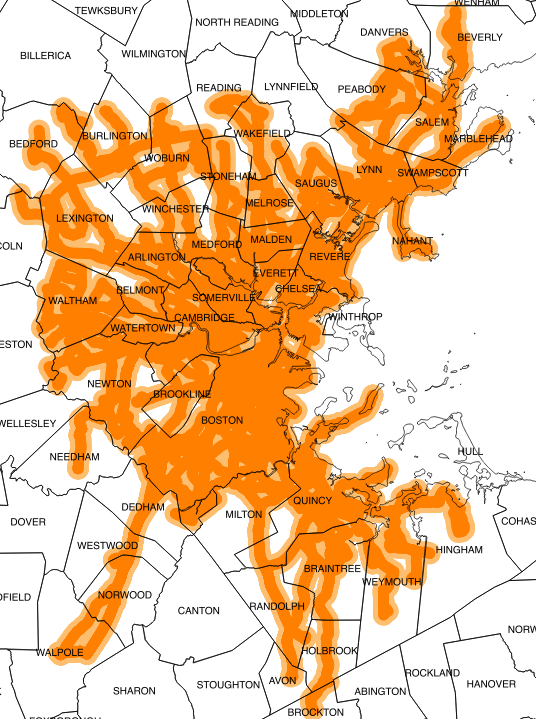I took the liberty to bike home this morning from running across the Harvard Bridge to check out the new bike lane there (sans phone, however, so no sexy pictures). Here are some quick observations:
- It needs flexi-posts. Too many drivers are used to using it as a right turn lane. Once installed, they should preclude that, which is where the real safety improvements come (that and No Turn on Red markings, which are long overdue; perhaps DCR and MassDOT will match with NTOR on the Cambridge side of the bridge). Whatever system is put in place needs to be kept year-round, with a snow-clearance plan (which includes the bridge, which MassDOT did not clear this past winter).
- Flexi-posts would be nice on to the bridge, which is always a bit harrowing with catch basins on the right and traffic on the left, but that would mean it would be hard to pass slower cyclists, a relatively frequent occurrence. Perhaps intermittent (every 30 meters/Smoots) posts that would still allow cyclists to change lanes would work. It’s also MassDOT territory and interagency cooperation is not a thing in Massachusetts.
- Once in place, there will no longer be the merge/bus stop/right turn hell that has been the situation there for years. (Or as vehicular cyclists would call it: paradise. To be dead serious for a moment: the previous situation at Mass and Beacon was exactly what vehicular cyclists advocate for: a free-for-all with bikes acting as cars. People died because of it. It is high time for the vehicular cyclists to be banished to the dustbin of history.)
- The bike lane westbound/northbound on Mass Ave (on the other side) has been striped quite wide—at least 8 feet—coming in to Beacon, where it shares a bus stop. This means that both travel lanes are just nine feet wide. If nine foot lanes are okay (and they should be) you could dramatically improve Mass Ave.
- The current lane off the bridge is probably the most important single block for a bicycle facility in the City of Boston, and perhaps the Commonwealth. It is heavily used, with high conflict rates and a steep downhill off the bridge which sent cyclists flying in to a sea of cars and bad pavement. So it’s the right place to start. But it’s just a start. The lane really needs to be extended all the way down Mass Ave (as has been proposed here and elsewhere).
- By moving the bus stop to Marlborough, a few parking spaces will be lost. And the M2 will have to find a new stop (I’m not sure where). In fact, it might make sense for both bus stops to be moved to either side of the Marlborough intersection, which would make my previous plan even more feasible (expect a redraft of that in the next couple of days).
- Still, I think that this is a huge change, because the city eliminated a lane of traffic without a months-long, drawn-out “traffic study” which would claim a reduction in LOS and that therefore a bicycle facility couldn’t be accommodated. Is it reactive instead of proactive? Yes. And that needs to change. But it sets a precedent: we can remove traffic lanes in the name of safety. And it’s now time to act for a safer Mass Ave, a safer Beacon Street, and safer streets all around.





